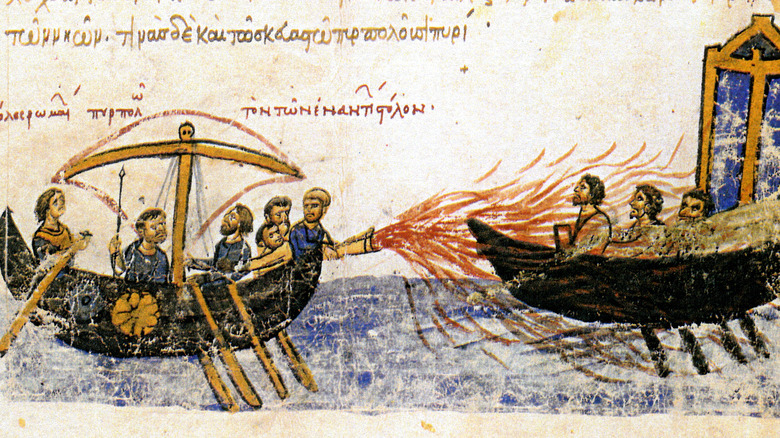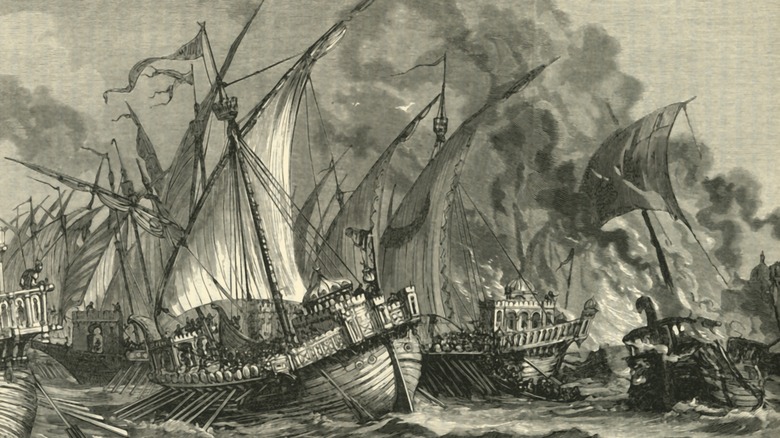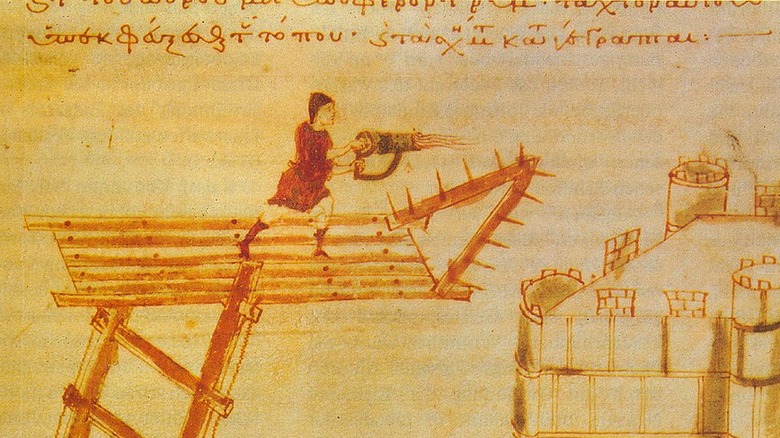The Truth About The Secret Weapon Of The Byzantine Empire
The flamethrower is a weapon often associated with 20th-century warfare. In World War I, the Imperial German Army was the first to make use of portable flamethrowers, while the British constructed a massive example called a Livens Projector. According to the Huffington Post, this weapon was static, intended to douse entire German trenches in a 130-foot stream of flame. By the Second World War, all of the principal Allied and Axis powers had their own portable flamethrower variants.
As the war progressed, different armored vehicles were even repurposed as flame tanks, capable of approaching enemy positions and making quick work of any unprotected infantry. Flamethrowers continued to see extensive use in the Vietnam War but afterward, napalm fell out of favor among the global community. While officially banned in modern warfare, the flamethrower's capacity for destruction has been immortalized in historical records and pop culture as people such as Elon Musk have produced their own. However, in spite of its relatively recent use, the flamethrower is, objectively, not an entirely new concept.
Napalm-like mixtures have been used in warfare for thousands of years
The use of incendiary weapons dates back thousands of years to ancient "fire-pots" and "fire arrows" meant to defend and attack walled cities. The latter are even attributed to the fall of Athens during the Persian invasion. Unlike the fire arrows commonly depicted in films, these historical examples are believed to have been coated in a flammable and adhesive resin that could not easily be put out. Once the city was breached, the few Athenian defenders left were helpless as their wooden barricades were set alight (via Erenow).
The chemical compounds used in such munitions varied over the centuries as different militaries experimented with them. The Byzantines, isolated as both Arab and Crusader encroachment threatened their sovereignty, came up with their own infamous concoction in the 7th Century A.D. (via Royal Museums Greenwich). Greek Fire became a staple of Byzantine warfare for centuries, during which the Empire used this revolutionary substance against its enemies in surprisingly recognizable ways (via Britannica).
As a naval weapon, Greek Fire could decimate whole enemy fleets
The Byzantines initially used Greek Fire as a naval weapon. With the likely use of a bronze pump, Byzantine ships would approach enemy vessels and douse them in the flaming liquid. By this point, the nightmare would begin for the enemy crew. Normally, fire on a ship could typically either be put out with water or, if the flames proved too much, the crew could abandon ship. Neither was an easy option with Greek Fire (via We Are The Mighty).
Not unlike the ancient fire arrows or modern napalm, it is described as having stuck to whatever was in its path. Evidently, not even the sea could stop it as the mixture could burn on the water's surface. Greek Fire was regarded as a war-winning weapon and was given credit for aiding in the destruction of several Arab fleets in the 670s. Since those fleets were previously unstoppable in their conquest of the Mediterranean, such a weapon had a severe impact on the Caliphate sailors' morale (via World History). Over two hundred years later in 941, it saw similarly devastating use against a Russian fleet in the Black Sea, effectively ending the Rus'-Byzantine war (via HeritageDaily).
On land, Greek Fire was used to crush rebels and enemies alike
Land armies that hoped to sack Constantinople, or otherwise rebel against it, were not safe from Greek Fire either. During military expeditions into the Balkans or rebellions, the Byzantines made frequent use of Greek Fire in more portable forms (via Interesting Engineering). Clay containers were commonly filled with the mixture and hurled at the enemy once an attached wick was lit (via Daily Mail). These were either small and thrown by hand, or large and launched by a trebuchet. For close-up use, siphons like those on ships were either positioned on walls or small enough to even be carried by one person.
What's remarkable is not only the effects these weapons had in battle but how one-sided the advantage they established was. This is because when siphons and Greek Fire were captured, a rare but not uncommon occurrence, the extreme secrecy of what the formula was kept them from developing their own supply (via Everything Everywhere). Records of Greek Fire's composition and use seem to have been lost after the 1204 Fall of Constantinople when much of the city was sacked by opportunistic crusaders. Though lost to time, it left an impression that has lasted for a millennium.



